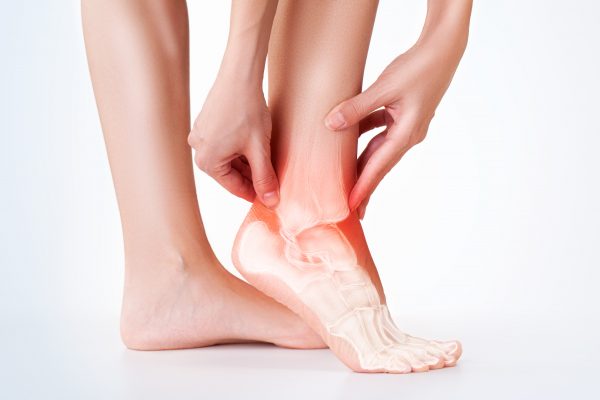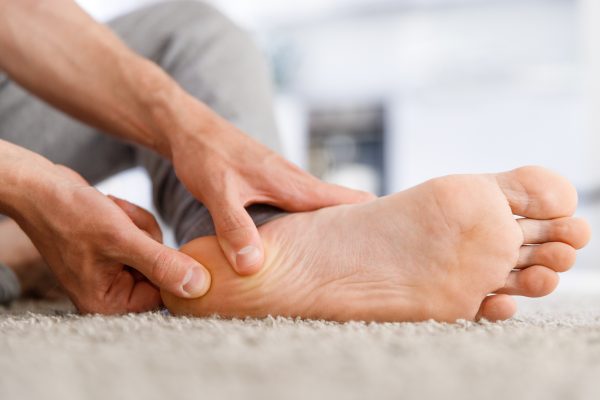Ankle pain can be extremely uncomfortable and interrupt the regular rhythm of your life. While it can be the result of an injury, there are a variety of ailments and causes of ankle pain that aren’t related to an accidental impact.
The following are six underlying conditions that could cause ankle pain without an injury:
1.) Achilles Tendonitis
Achilles tendonitis is an overuse injury affecting the Achilles’ tendon. The Achilles tendon is the band of tissue that connects the lower leg (calf muscles) to the heel bone.
This condition usually occurs in runners but is also common in those who only play sports on occasion, because their bodies aren’t accustomed to the activity level. Many cases of Achilles tendonitis can be treated successfully with simple home remedies, however, more severe cases can require surgery.
2.) Bursitis/Joint Inflammation
The bursa is a fluid-filled sac that cushions the space between your tendon and bone. Ankle bursitis is a condition that occurs when this area becomes inflamed. It can cause tenderness and pain in the back of the ankle, resulting in limping or stiff movement within the ankle joint.

This type of pain can be the result of wearing improperly fitting shoes or overusing the joint through various physical activities. In some cases, just reducing your activity level can allow the joint to heal and the inflammation to subside, however, in some cases, additional treatments are necessary.
3.) Gout
Gout occurs when uric acid builds up in the joint. It often results in severe pain, swelling and more and is usually described as feeling as if your foot is on fire. Thankfully, there are many ways to treat gout from the comfort of your home. If these treatments don’t help enough, making an appointment to visit a foot health professional is advised.
4.) Osteoarthritis
This is the most common form of arthritis and impacts the lives of millions of people on a global level. Osteoarthritis happens when the cartilage located at the end of the bone begins to wear down. This cartilage serves to protect and cushion the end of the bones, so when wear occurs, damage to the joint often results.

The symptoms of this condition include stiffness, pain, swelling, grating, and tenderness within the joint as well as a loss of flexibility. Ankle joint pain that won’t go away with home treatments should be evaluated by a podiatrist.
5.) Rheumatoid Arthritis
This chronic inflammatory disorder affects more than the joints in your ankle. It involves the lining of the joint, triggering an autoimmune response, where your body begins to fight against itself.
Symptoms of rheumatoid arthritis are similar to other types of arthritis and include joint stiffness and swelling, as well as joints that are tender and warm to the touch. This condition can flare up and vary in severity from episode to episode. It can even go into remission for a time. If you have persistent discomfort in your ankle joint that you think might be the result of rheumatoid arthritis, seek medical attention.
6.) Plantar Fasciitis
This condition is the cause of the vast majority of heel pain. It happens when the thick band of tissue that connects your toes to your heel bone, via the bottom on your foot, becomes inflamed. To picture this, think about a bowstring.
Symptoms of plantar fasciitis include stabbing pain near the heel on the bottom of the foot, most often when you first get up in the morning. As you move around throughout the day, you will likely note a decrease in your level of pain. It can return when you stand or get up after being seated for long periods of time.

Although anyone can experience plantar fasciitis, runners are the most susceptible. Those who wear shoes that don’t provide adequate support and individuals who are overweight are also at an increased risk. If left alone, your plantar fasciitis can become noticeably worse and eventually impact your ability to function regularly.
When to Get Checked
If you are experiencing any of the conditions above and have not been able to achieve adequate relief through over-the-counter or DIY treatment methods, it’s likely time to come see us at Foot & Ankle Group.
For many of these conditions, going untreated could result in a more serious condition or chronic pain. Thankfully, our offices are committed to seeing you as soon as possible, sometimes even the same day if your pain is severe.
Don’t wait longer than necessary to get relief for your ankle pain. Call us today!
Categorized in: Blog
Comments are closed